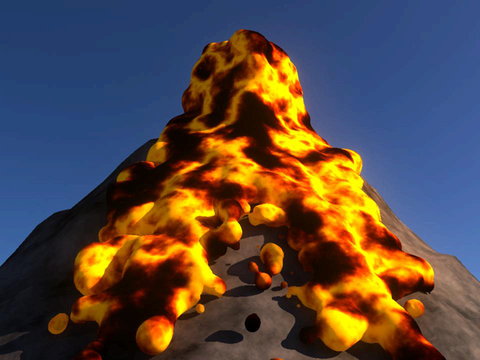
Using Liquid Simulation attributes, you can add properties to your nParticle objects to make them look and behave like flowing liquids. Liquid Simulation attributes let you to create simulations, ranging from slow moving lava, mud splatters, droplets of liquids, and splashes of water.
For liquid simulations, choose the Water nParticle style when you create your object. Using the Water nParticle style presets some nParticle attributes, which provide a good starting point for most liquid simulations.
You can use Ball, Cloud, and Thick Cloud nParticles styles for liquid simulations, however you will need to turn on Liquid Simulation as well as adjust other nParticle attributes.
Depending on the liquid characteristics you want to achieve, there are a number of attributes that you can set for your simulation. Use the following information as a guide to obtaining the desired results:
| nParticle attribute | Effect on liquid simulations |
|---|---|
| Self Collide | To create a liquid simulation, ensure that Self Collide is turned off. See Self Collide. |
| Collide Width Scale | When liquid nParticles are contained in geometry, such as a passive collision glass, you may need to adjust the nParticle Collide Width Scale to avoid interpenetrations. See Collide Width Scale. |
| Enable Liquid Simulation | Enables nParticle to overlap, which forms the continuous surface of the liquid. Ensure that Enable Liquid Simulation is on. See Enable Liquid Simulation. |
| Radius | Determines the overall surface of the nParticle liquid. Increasing Radius can increase the tendency of particle overlap, and therefore improves the smoothness of the liquid's surface. The amount nParticles overlap is also determined by Liquid Radius Scale. Adjusting Radius can also affect nParticle collisions and increasing it too much may result in interpenetrations with other Nucleus objects. See Radius. |
| Liquid Radius Scale | Specifies the amount nParticles overlap. Increasing Liquid Radius Scale increase the volume of the liquid. For contained liquids, values greater than 1.0 may force particles out of the container, making your simulation unstable. At values less than 0.1, nParticles may not overlap enough to create a continuous surface. See Liquid Radius Scale. |
| Incompressibility | Specifies the amount nParticles resist compression. Contained liquids do not react as sensitively to Incompressibility as they do to Liquid Radius Scale. This means that you can set Incompressibility to higher values and your simulation still settles quickly and remains stable. For viscous liquids use high values. See Incompressibility. |
| Viscosity | Adds viscosity to the liquid making it appear thicker and more resistant to flow. You can use the Viscosity Scale ramp to set per-particle viscosity to nParticle properties such as Age to create the effects of liquid becoming more viscous as it ages. See Viscosity and Viscosity Scale. |
| Surface Tension | Adds a weak cohesive force to keep individual nParticles together. This is useful for maintaining the liquid's surface when it is flowing or suspended. You can set Surface Tension on a per-particle basis using Surface Tension Scale. See Surface Tension and Surface Tension Scale. |
| Threshold | Threshold determines the size and smoothness of the nParticle’s rendered surface by controlling the density of the overlapping particles. Threshold affects how particles render, but it does not affect how the particles behave in the simulation. See Threshold and Set Threshold. |
Liquid Simulation nParticles work best for contained liquids and small scale liquid flows. For large scale water effects, such as oceans, lakes, or swimming pools, use Maya Ocean or Pond effects. You can use an nParticle liquid simulations with an Ocean effect to create the splashes caused by the wakes in the fluid. See Open water effectsin the Fluid Effects guide.
After you setting up your nParticle liquid simulation, you can convert the nParticle object to a polygon mesh by selecting Modify > Convert > nParticle to Polygons. You can optimize your nParticle output meshes using nParticle Output Mesh attributes. See nParticle output meshes.